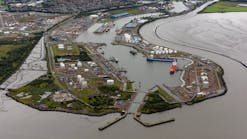Michael HanrattyOur South Central Kentucky exploration program has developed methodically since its inception in late 1991.
Consulting geophysicist
Grapevine, Tex.
Clinton County, Ky., is on the eastern flank of the Cincinnati arch and the western edge of the Appalachian basin and the Pine Mountain overthrust (Fig. 1 [19780 bytes]). Clinton County has long been known for high volume fractured carbonate wells.
The discovery of these fractured reservoirs, unfortunately, has historically been serendipitous. Our efforts have been to explore and understand these fractured reservoirs.
Seismic evolution
Shooting shallow seismic in the rough terrain of Clinton County has proved challenging. It proved most difficult to resolve and image the high volume fractured Lower and Middle Ordovician carbonate reservoirs. Our first seismic efforts were 2D shoots that resolved fractures quite nicely but could not resolve healed or filled fractures or the attitude.
Our latest 3D seismic efforts have produced two discovery wells in fractured reservoirs and four additional uncompleted wells with various heights of standing oil and flowing gas. All wells encountered oil filled fractures where expected. Recent analysis has yielded the final missing piece-quantitative reservoir estimates.
We recognize now that the size relationship of the reservoirs is linear. Reservoirs can generally be estimated using 55 cu ft of signature for each barrel of oil recoverable. The area of the signature is calculated on uncontoured 3D instantaneous frequency data on inlines, crosslines, and 2 msec time slices. This interpretation is performed on a personal computer workstation.
Research and development have progressed slowly. We systematically eliminated nonproducing anomalies and resolved our targets. This was accomplished by integrating data from dry holes, marginal and successful holes, logged wells, and new seismic acquisition over producing wells.
Success rates
We have been able to improve the old regional economic success rate from one in 30 to a more reasonable one in eight by simply using standard seismic amplitude plot interpretations.
Refinements evolved by employing post-stack attribute processing and utilizing an expanded sonic log and synthetic base. With this, we improved our commercial success rate to one in three in wildcat drilling. Using our further expanded data base and the reprocessing of our existing data, we firmly expect a minimum of one in two wildcat prospects to be commercially viable.
As we supplement discoveries with development drilling, we reasonably expect our economic success rate to rise as high as three in four. The real strength of this evolution has been our ability to directly image the productive reservoir both in quality and quantity. We have calibrated from known geology of some 30 wells to the seismic data using standard geophysical methods. The amplitude data can easily resolve fracture locations, but the color frequency work is essential in resolving the content of fractures. Seismic stratigraphy has yielded the production models and some geological sequence history.
Exploration methods
We currently use 2D seismic and satellite imagery to design 3D high resolution seismic shoots. This method has proven to be the most efficient and is the core of our program.
High resolution satellite imagery (either French or Russian) is used to interpret the seams between surface block patterns as well as regional surface faults. Then 2D seismic lines and swaths are acquired to define these intersections on the ground.
The area around these intersections has proven to be the most productive with abundant yields of production signatured prospects. The 3D seismic shoots can then be designed to maximize efficiency and prospect yield.
This has significantly reduced costs by eliminating any need to shoot up all of the countryside. We own and operate several seismic rigs to improve quality and cost control.
Seismic acquisition
Our choice of equipment is the 48 channel Texas Instruments DFS-III. We have used several more modern seismic rigs without improvements in data quality. This equipment was chosen because of its rugged construction, very low cost, low operating expense, and ease of field maintenance and operation. It can be run using a three man crew. Geophones and cables are quite inexpensive and abundant.
This equipment is probably the most versatile and common ever used and is currently considered by others to be obsolete. The DFS-III has been responsible for the vast majority of all seismic oil discoveries. After extensive field tests it was determined that a 12 gauge shotgun is the ideal shot source due to its wide frequency band and almost white (bi-modal) signal.
Poor boy 3D data
All data were shot using a shoestring budget and simply processed by a commercial processor, Geotrace Technologies Inc.
Geotrace has been quite generous both by charging only a minimum for our jobs and in slipping our projects into its busy processing schedule between larger jobs. This is possible due to the negligible size and short run time of these relatively small sized 3D data sets. The attention we receive is the same as the large clients, and the service is excellent.
Geotrace's quick turnaround has actually made it possible on 3D data to shoot, process, stake, permit, and begin drilling a location in 2 weeks. In-house costs to shoot, process, and interpret data can be in the range of $15,000-$25,000. This is close to the cost to drill and test a single well.
Our 3D grids range from about 45-75 acres. The bin sizes are 55 ft by 55 ft. The terrain and shallow targets are such that a larger grid is rarely beneficial. This array can be expanded to cover 160-320 acres. Our group intervals are 110 ft, and our shot intervals are 55 ft.
Shot source is a light load 12 gauge shotgun. Recording sample rate is 2 msec. No notch filters are applied, and high cut filters are well over 100 hz.
Shot points are repeated at least three times with the ends of the shot lines repeated at least 10 times. Shot lines and receiver lines have 330 ft spacing.
All shot points are hand edited prior to summing. Repeated testing has yielded this shooting array and method. Surface surveys are currently supplied by local vendors and hand corrected prior to processing.
Well data base
Some 30 well examples are the basis of our exploration program.
Our exploration program is a simple application of standard seismic techniques employed by every major oil exploration company. We have used this data base to resolve reservoir size as well as content by simply calibrating back to known productive wells.
Our data base includes the jumbo sized wells (in excess of 70,000 bbl cumulative production), show wells, and dry holes. All data were shot prior to complete depletion of the production signature. The production model successfully predicts the presence of free oil in over 95% of the wells in our data base within the 65-200 msec time range.
Seismic interpretation
The seismic data throughout Clinton County, Ky., and some in Overton County, Tenn., display quite similar characteristics. Seismic stratigraphy and our well data yield the following interpretation:
Enhanced reflectors and disturbed zones are predominate with turbid zones. All of these characteristics seem to be the result of seepage and entrapment of hydrocarbon gases.
Throughout our seismic data there are small intrasedimentary domings, flat beddings, and zones of mineralization. The doming appears to be the result of blind thrust faults, which are common. The seismic flat spots or beddings are of undetermined source. Biological matting (algal or bacterial) or a fracture (karst) filled with long stable corrosive waters are two possible sources. It is not a current water table.
The higher frequency mineralized zones that bound and cap most reservoirs seem to be hydrothermal and historically precede the oil migration. These commonly include quartz and dolomite. Low frequency mineralized zones are small grained druse with trapped low pressure gas associated with it.
Breccias and collapsed structures are also present and seem to be the recent result of a more corrosive agent migrating along fractures. The seismic data indicate that mineralization, water, and oil have migrated up from depth along fractures and faults, altering the adjacent rock. Seismic basement seems to be at a significantly greater depth.
Our developed production model requires little interpretation other than size estimation. The substantial presence of the acoustic signature of a narrow frequency band in instantaneous frequency seismic data is the simple model.
This unique signature is due to direct seismic hydrocarbon detection.
The instantaneous frequency acoustic signature that correlates to mobile hydrocarbons is displayed in color data (Figs. 3 [110277 bytes] and 5 [86881 bytes]) as the black contoured value range. This corresponds to the 34-40 hz range. The 40-46 hz range (near black-yellow range) is associated with the reservoir but is lower in permeability and porosity and produces more gas and less oil.
Water, gas, calcite, chert, and dolostones can also be resolved with unique narrow frequency bands. This is caused by the effect of solution gas in the mobile oil as well as the unique crystalline nature of the quartz and secondary fills. Production waters have had no associated suspended gas. We have documented a quite similar signature present in similarly aged rocks and reservoirs of the Hardeman basin of Texas and Oklahoma.
3D lease data
The Dalton lease data (Figs. 2 [68294 bytes] and 3 [110277 bytes]) reflect a horizontal styled fracture envelope filled with oil and a gas expansion drive, while the Dickerson lease data (Figs. 4 [57434 bytes] and 5 [86881 bytes]) reflect a vertical styled fracture envelope filled the same. All data wells indicated vertical fractures at the wellbores when such data were available. Our data indicate both styles of fractures are quite abundant. These examples are the analogs of our production model.
The two data sets included are 3D examples of seismic data in Clinton County, Ky., and are presented in both the standard black and white amplitude and the instantaneous frequency color plots. Local drillers names are used where formations tops are shown. Time to depth conversions were done using local sonics and synthetic logs.
The Dalton lease data were shot on Dec. 30, 1992, following the last of the three wells going on line (around Oct. 8, 1992).
The data reveal only a partial depletion of our production signature due to the 4D effect of production depletion. These three wells provided the analog for the Touchwood Resources 1 Dickerson discovery well.
The Dickerson lease data were acquired on July 10, 1994, prior to drilling, which was completed on Sept. 26, 1994, and resulted in a 74 b/d oil discovery well of limited reserves. After the well produced several thousand barrels of oil, it was deepened and lost to a failed frac treatment. This well was actually our second discovery well using this method.
Conclusion
The seismic production signature and model we have developed in South Central Kentucky should prove most helpful in exploitation of oil resources.
The quickly recovered, high volume oil production from these fractures coupled with this cost effective exploration technique should make the economics of this fracture play most attractive. South Central Kentucky and North Central Tennessee have much to offer.
Acknowledgments
Thanks to the following:
Richard Karpe, Los Lunas, N.M., for continued support and extensive field assistance; Martin Hovland, Statoil, Stavanger, Norway, for extensive published ideas and works on seepage, mineralization, and pockmarks; James A. Drahovzal and the Kentucky Geological Survey staff for permission to use their formally published location map and their continuing support and help; James T. Rutledge of Los Alamos Laboratories, N.M., for reality checks and velocity help; Eddie Wallace of Touchwood Resources, Midland, Tex., for continued support; and John Bell and Earl Price of Bell and Murphy & Associates, Dallas, for their help, ideas, support, and workstation.
Appreciation goes to George Meyer, College of the Desert, Rancho Mirage, Calif., George Shor, Scripps Institute of Oceanography, San Diego, and the late Mark Landisman, formerly of University of Texas-Dallas, for their devotion to teaching and profound influences.
The Author
Michael P. Hanratty is an independent consulting geophysicist in Grapevine, Tex. He has been a consultant since receiving a BS in geoscience with geophysical emphases from the University of Texas-Dallas in 1984.He has owned and operated seismic rigs since 1991. His areas of interest include inversion and attribute interpretations of high resolution 3D seismic data in frontier areas for fracture and reef exploration.
Copyright 1996 Oil & Gas Journal. All Rights Reserved.



